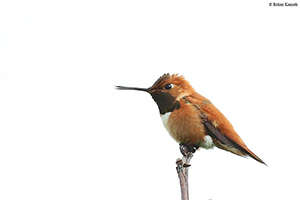Humminbirds, Nectar and Water |
|
|---|---|

photograph of a Rufous Hummingbird by Rohan Kamath |
Hummingbirds feed on copious quantities of nectar. When, for example, a Broad-tailed or Rufous Hummingbird is subsisting on the nectar of scarlet gilias in subalpine areas of Colorado, it must take in more than its normal body water content every day in order to get enough sugar to fuel its metabolism. (It gets fats and protein by also feeding on small insects.) Its kidneys must work very effectively to retain needed body salts while removing the excess water that floods them after sugar is absorbed from the nectar. In spite of their small size, and thus natural susceptibility to evaporative loss of water (since they have a huge area relative to their volume), small hummingbirds in the laboratory fed on synthetic gilia nectar produced urine and cloacal fluid (the latter being water passed directly through the gut) amounting to 75-85 percent of their body weight daily. That is the rough equivalent of a human adult voiding 20 gallons of water a day! |
| SEE:
Determining Diets;
Hummingbird Foraging Bouts;
Optimally Foraging Hummers;
Diet and Nutrition. Copyright ® 1988 by Paul R. Ehrlich, David S. Dobkin, and Darryl Wheye. |
|